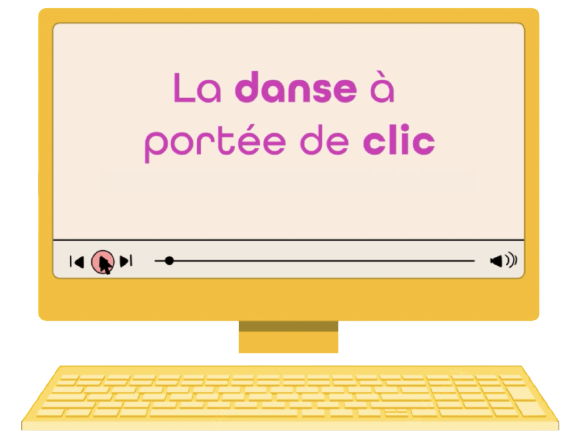Episode 9 - Demystifying copyright
Emmalie and Stéphanie called on music producer and sound engineer, Guillermo Escobar, to create a soundtrack for their choreographic creation It’s Fine. They want to draw up an agreement to formalize their cooperation and have questions about preserving their copyright as authors in a digital context. What items need to be discussed before broadcasting a recorded work on the Web? William Audet, a lawyer specializing in copyright and digital media, offers them invaluable advice and demystifies several concepts, such as copyright, reproduction, and assignment of image rights.

Play Video
Share on social media
Follow us

- Advice from our experts
Elements to consider when licensing or assigning copyright
It is recommended to draw up an agreement to protect copyright. This document, written by William Audet, a lawyer specializing in copyright and digital media, summarizes some elements to consider when drafting an agreement to protect copyright.
Learn more
Frequently Asked Questions about copyright
This resource reviews the basics of intellectual property and some specifics related to broadcasting on online platforms.
Learn more

- Some concepts to explore
The owner of the copyright of a work or other object may assign that right. Assignment essentially means transferring ownership interests in a work. The assignee has full ownership rights to the copyright assigned by the assignor. The assignee of interest in a copyright is the holder of the copyright and thus has enforceable rights, including the right to take legal action against the assignor for infringement of copyright, since the assignor is no longer the owner of the assigned copyright.
The assignment is not valid unless it is in writing and signed by the owner of the right, or their duly authorized agent.
A right may be assigned wholly or partially, or the assignment may only apply to one part of the exclusive rights. An assignment cannot include any restrictions.
A licence is not the authorization to commit what would otherwise be an infringement of copyright. By licensing, the owner of the copyright permits another person (the licensee) to perform the actions exclusively reserved for the owner of those rights. The licensee enjoys only contractual rights and has no ownership over the copyright.
A non-exclusive licence does not need to be written and signed by the owner of the right. It is strongly recommended, however, to always put the licence agreement in writing and not rely solely on a verbal licence agreement.
An exclusive licence is the authorization given to a licensee to exclusively perform an action covered by copyright, regardless of whether this authorization is given by the owner of the copyright or by a person who already holds an exclusive licence.
The exclusive licence exists in copyright law when the following conditions are met:
a) the copyright owner (licensor) authorizes another person (the licensee) to perform an action covered by this copyright; b) the licensor promises not to grant this permission to another party for the term of the licence; c) the licensor promises, for the term of the licence, not to perform the actions that he or she authorized the licensee to perform.
The exclusive licence is not valid unless it is written and signed by the owner of the right, or by his or her duly authorized agent.
Exclusive licences often contain restrictions regarding the term of the licence, territory, and types of media on which the work can be distributed.
The Copyright Act confers moral rights. The author of a work has the right to the integrity of the work, claim to its creation, even under a pseudonym, and right to anonymity. Infringement of the right to integrity occurs when the work is deformed, mutilated or otherwise modified or used with another product, cause, service or institution in a manner that is prejudicial to the honour or reputation of the author. Moral rights are non-transferable but can be waived at any time, in whole or in part. It is common to find a clause waiving moral rights in copyright assignment contracts.
An infringement of copyright occurs when any person does, without the consent of the owner of the copyright, anything that only the owner of the copyright has the right to do.
It is important to remember that one of the rights conferred under the Copyright Act is communicating a literary, dramatic, musical, or artistic work to the public by telecommunication. Communicating to the public by telecommunication consists of putting a copyrighted work or other object at the disposal of the public by telecommunication, so that each person can have access to a place and time of their own choosing. For example, streaming a work, such as a video on the Internet, generally constitutes communicating to the public by telecommunication. Before putting a work online, it is always prudent to obtain written authorization from the work’s author.
The Copyright Act provides for many exceptions to infringements of copyright. In particular, subject to certain conditions, fair use of a copyrighted work or other object for private study, research, education, parody, satire, critique or the reporting or communication of news does not constitute an infringement of copyright. There are several other exceptions, such as the exception for non-commercial content generated by the user or the reproduction for private purposes, to name just a few. Determining if an action is covered by one of the exceptions provided under the Copyright Act is often a complex problem that requires consideration of several factors developed by the Court and/or certain criteria set out in the Act. Extreme caution is advised before relying on one of the exceptions provided under the Act to perform any unauthorized action that normally requires the authorization of the owner of the copyright.
As a general rule, copyright on a work subsists for the life of the author, the remainder of the calendar year in which the author dies, and a period of 50 years following the end of that calendar year. It should be noted that the usual term of copyright protection will soon be extended to 70 years following the author’s death, in accordance with the Canada-United States-Mexico Agreement (CUSMA).
In the case of works of joint authorship (i.e., works created with the collaboration of two or more authors, in which the part created by one is not distinct from that created by the other or others), copyright subsists during the life of the author who dies last, for the remainder of the calendar year of that author’s death, and for a period of 50 years following the end of that calendar year (soon to be 70 years).
In the case of works where the identity of the author is unknown, copyright in the work shall subsist until the end of 75 years following the end of the calendar year in which the work was made.
In the case of cinematographic works (except for cinematographic works in which the arrangement or acting form or the combination of incidents represented give the work a dramatic character), copyright in a cinematographic work subsists until the end of 70 years following the end of the calendar year in which the cinematographic work is made.
In the case of performances, copyright subsists until the end of the five years following the end of the calendar year of execution (however, exceptions apply to performances captured in a sound recording).
For more details, consult the diagram prepared by the University of Alberta and the University of Ottawa. https://www.ualberta.ca/faculty-and-staff/copyright/intro-to-copyright-law/licensed-royalty-free-content/pd-flowchart-full—20apr2021.pdfv

Menu

